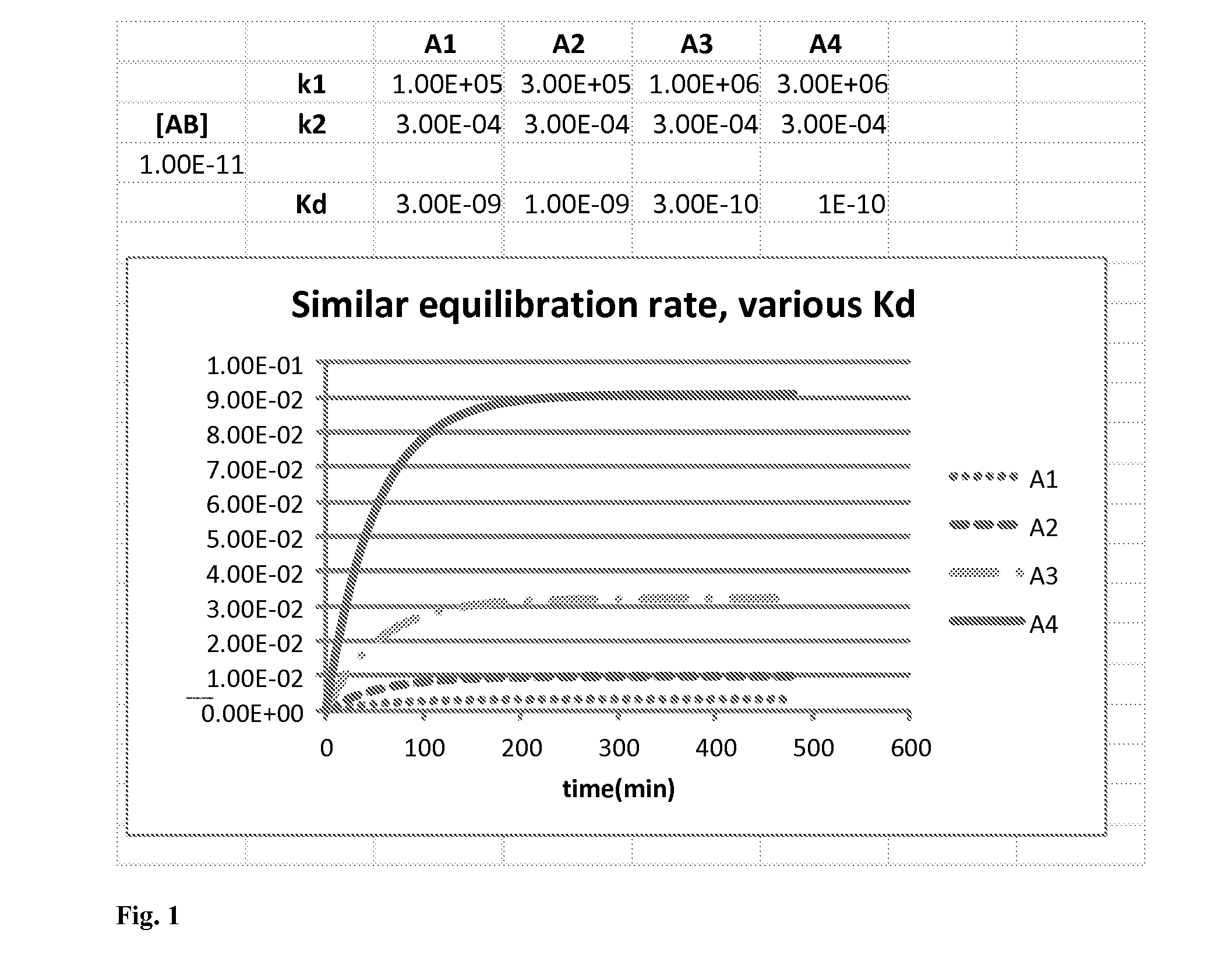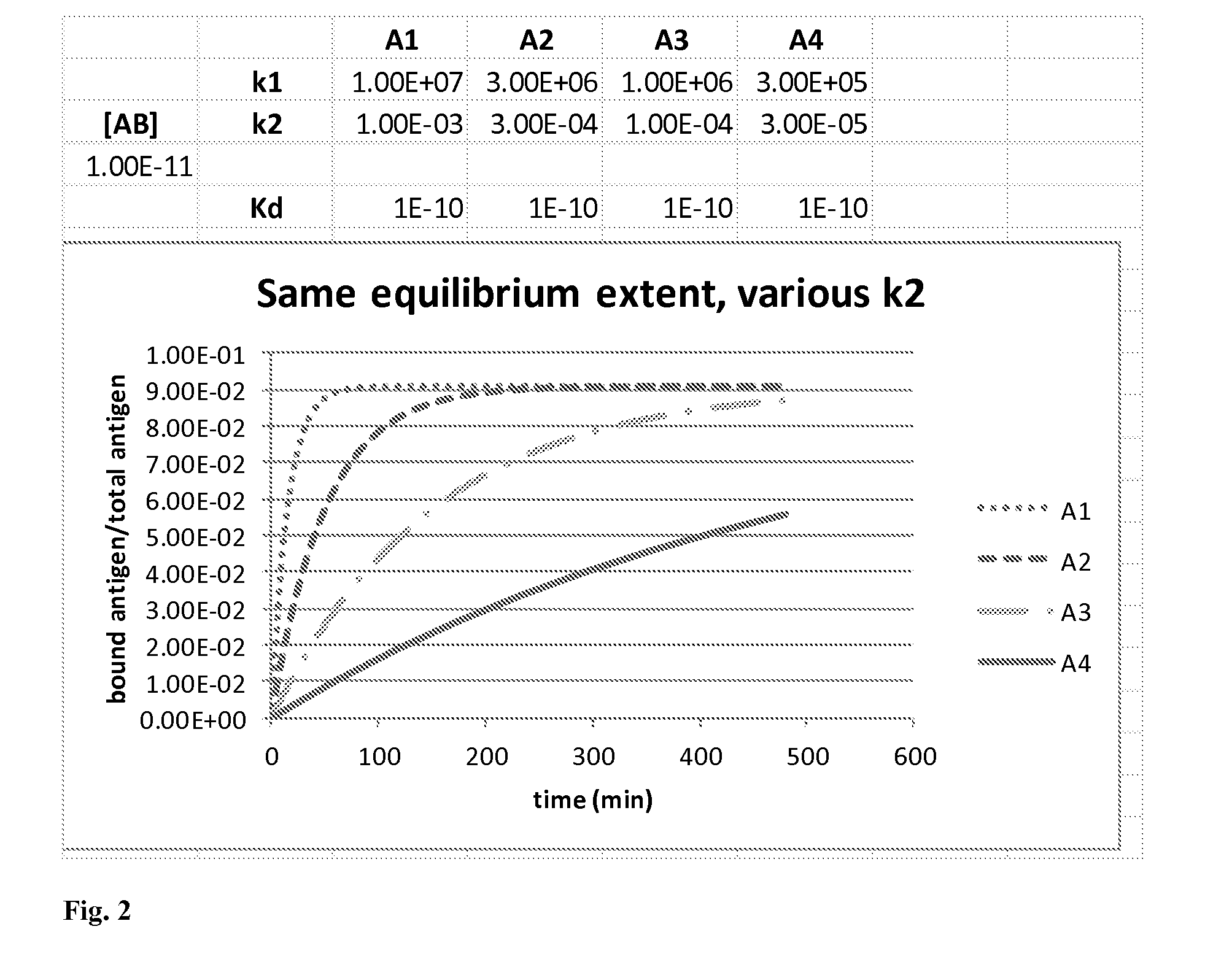Non-equilibrium two-site assays for linear, ultrasensitive analyte detection
- Summary
- Abstract
- Description
- Claims
- Application Information
AI Technical Summary
Benefits of technology
Problems solved by technology
Method used
Image
Examples
example 1
Assays
[0302]An embodiment of an assay described herein is a two site monoclonal antibody immunoassay for the quantitative measurement of analyte, including any of the analytes set forth above. In some embodiments the immunoassay will be a PCR immunoassay. The method is capable of precise and accurate detection of very low analyte concentrations in samples and can detect analyte present at concentrations present in samples at about 100 fg / mL and as low as about 10 fg / mL.
[0303]One exemplary immuno PCR assay of the instant invention employs a soluble (reporter) monoclonal antibody (MAb), labeled with an assay specific double-stranded DNA sequence. The presence of this DNA label does not interfere with MAb binding, and the MAb does not interfere with DNA label detection. The second capture MAb specific for another site on the analyte was coated onto paramagnetic microparticles.
[0304]The reporter MAb-DNA conjugate is reacted with sample in a microtiter plate format to form a first immune...
example 2
HIV p24 Assay
[0312]It was surprisingly found in the assays of this invention that using a reporter antibody having a relatively slow dissociation rate constant gave rise to an exquisitely sensitive assay. For example, it was surprisingly discovered that a two-site immuno-PCR assay using an antibody with a dissociation rate constant less than 5.9×10−5 sec−1 provided an assay capable of detecting at least as low as 0.1 fM of analyte—orders of magnitude lower than other reported assays.
[0313]It was thus surprisingly discovered that the rate of equilibration of analyte binding may be determined primarily by k2, rather than k1 or Kd and / or any combination of reactant concentrations, and that the population of unbound analyte approximates a first order exponential decay from 100% unbound analyte to the equilibrium fraction of bound analyte. It is also surprisingly found that a relatively slow dissociation rate constant is critical to assay design and may be more critical to assay sensitiv...
example 2a
Determination of Optimal Concentration for the Reporter Antibody-DNA Conjugate for HIV p24 Detection by Immuno-PCR
[0346]This experiment demonstrated an exemplary assay for the detection of HIV p24. The experiment was designed to determine the signal differences between 1% BSA / PBS / 0.1 mg / mL, Salmon Sperm blanks, and the same matrix spiked with 0.1 pg / mL HIV p24 when assayed using various concentrations of reporter antibody (reporter anti-HIV p24 Ab) between 2.5 and 50 pM.
Methods:
[0347]50 uL of reporter Ab stock was prepared by diluting BSA / PBS.
[0348]25 uL of BSA / PBS, or 0.1 pg / mL HIV p24 in BSA / PBS was loaded into appropriate wells (triplicate determinations for each reporter Ab concentration tested including a zero reporter Ab condition).
[0349]75 uL of appropriate reporter Ab mix was added to each well, and the mixture was incubated for 2 hrs.
[0350]10 uL of Target Capture Reagent was added and incubated for 30 min with mixing on platform shaker at 500 rpm.
[0351]The particles were se...
PUM
| Property | Measurement | Unit |
|---|---|---|
| Time | aaaaa | aaaaa |
| Concentration | aaaaa | aaaaa |
| Concentration | aaaaa | aaaaa |
Abstract
Description
Claims
Application Information
 Login to View More
Login to View More - R&D
- Intellectual Property
- Life Sciences
- Materials
- Tech Scout
- Unparalleled Data Quality
- Higher Quality Content
- 60% Fewer Hallucinations
Browse by: Latest US Patents, China's latest patents, Technical Efficacy Thesaurus, Application Domain, Technology Topic, Popular Technical Reports.
© 2025 PatSnap. All rights reserved.Legal|Privacy policy|Modern Slavery Act Transparency Statement|Sitemap|About US| Contact US: help@patsnap.com



